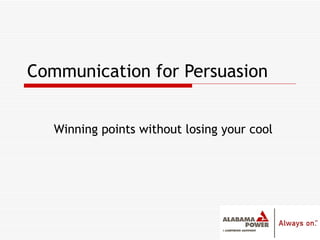General presentation skills
- 1. Communication for Persuasion Winning points without losing your cool
- 2. Communication for Persuasion Blueprint: The Power of Story Building a Foundation Finishing with Passion Telling Your Story Keeping your cool Dealing with media
- 3. The Power of Story 1 WhatˇŻs the most important part of a story? Impression Takeaway Unifying theme
- 4. The Power of Story Higher Purpose Intellectual Exercise Rote Movement Spiritual Mental Physical
- 5. The Power of Story People have more facts than they can use. Story is the framing that gives context.
- 6. The Framework of Story Foundation Structure Finishing
- 7. The Framework of Story Foundation Foundation built on common ground Study Yourself Study Your Audience Look for Parallels Same path, different time Same emotion or confusion Similar backgrounds Anything topical ? ? X= !!
- 8. The Framework of Story Parallelogram: a regular closed quadrilateral with opposite sides of equal length and opposite angles of equal degree. Analogy and Metaphor What is this shape? Parallelogram: A rectangle that leans
- 9. The Framework of Story Analogy and Metaphor A rectangle that leans ˇ start from a common experience, then transition to focus on the differences. Definition by Subtraction
- 10. The Framework of Story Structure Always start with STORY Story must answer: Who are you? Why are you here? What do you want?
- 11. The Framework of Story Structure Story Point
- 12. The Framework of Story The Rule of Threes Structure Points Lock stock and barrel Hook line and sinker Huey Dewey and Louie Easy for you to remember Easy for them to remember
- 13. The Framework of Story The Order of Points Structure Points Narrative Chronological Priority You decide
- 14. The Framework of Story The Properties of Points Structure Points Can be subdivided Each ˇ°branchˇ± has structure Assertion Evidence Conclusion
- 15. The Framework of Story The Properties of Evidence Structure Points - evidence Can singular or plural Different types Anecdote Fact Reason/Logic Demonstration
- 16. The Framework of Story The end is your beginning Structure THE Point (the Conclusion) One call to action One impression One point Build your presentation to finish where you want your audience to finish
- 17. The Framework of Story Finishing the story Foundation Structure Finishing Make it your story Add the details only you can You are the expert
- 18. Telling Your Story Storytelling in three formats: 1 Sentence 30 Seconds 90 Seconds gets to the point basic structure complex structure ! ? ! ? ! ! ! !
- 19. Keeping your Cool Body Language Posture Gestures Stance Direction Leaning in or away? Pointed fingers? Closed arms? Closed legs? Up lifts ¨C down douses
- 20. Keeping your Cool Voice inflection Volume Pitch Speed Silence Quiet defeats shouts High is trying too hard Fast is a sign of frustration Resets attention
- 21. Dealing with the media What Makes News ˇ°Newsˇ± The Three CONs Reporter Lingo, Tricks and Traps Performance Tips
- 22. Universal appeal Conflict Consumer Curiosity The ˇ°Out-of-the-Ordinaryˇ± Financial Stakes What makes News ˇ°NEWSˇ±
- 23. The Three CONs Control the Interview Content that Matters Containing the Damage
- 24. Control the Interview Time Deep breath Awareness of deadlines Place Comfortable for you Comfortable for camera (and light)
- 25. Content that Matters Define your Key Message What do you want people to remember about Alabama Power after this story runs?ˇ± ˇ° The police acted stupidly.ˇ± ˇ° All I heard was a Whoo-Whoo-Whoo!ˇ±
- 26. Content that Matters Examples of a Key Message Alabama Power is committed to safety We are good environmental stewards We try to balance the needs of our communities
- 27. Content that Matters A Key Message is not a Talking Point Talking points are pieces of evidence that get summarized and stored Create your Key Message, then develop Talking Points that support it Fits on a business card.
- 28. Contain the Damage Keep answers pertinent to Alabama Power DonˇŻt speak on behalf of other organizations DonˇŻt come to unwarranted conclusions
- 29. Reporter Lingo Off-the-record Can be used, just not with your name NOT a solid legal protection ˇ° Deep backgroundˇ± Reporter canˇŻt use it Reporter must find another source Define the terms for yourself ! ! !
- 30. Reporter Tricks and Traps Loaded questions You are allowed to question the premise Unattributed accusations Who are ˇ°someˇ± and ˇ°they?ˇ± The Silent Nod DonˇŻt fill the gaps ¨C answer then shut up
- 31. DonˇŻt look at the lens DonˇŻt back-light yourself DonˇŻt worry about ˇ°umˇ± and ˇ°uhˇ± Keep your Key Message handy Interview Tips
- 32. DonˇŻt deal with print immediately Ask whoˇŻll be doing the editing DonˇŻt be afraid to say ˇ°I donˇŻt knowˇ± DonˇŻt be afraid to offer an answer at a later time (within the deadline) Interview Tips
- 33. Be confidentˇ YOU are the source DonˇŻt be rattled by repeat questions End on your Key Message (ˇ°Anything I didnˇŻt askˇ?ˇ±) Interview Tips

































